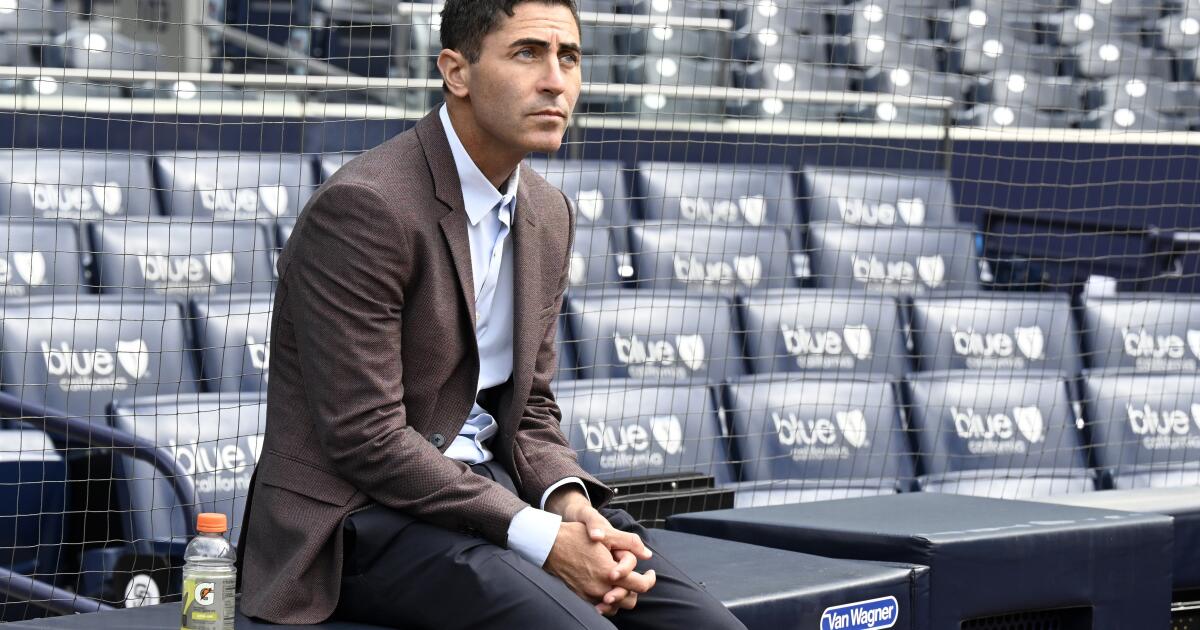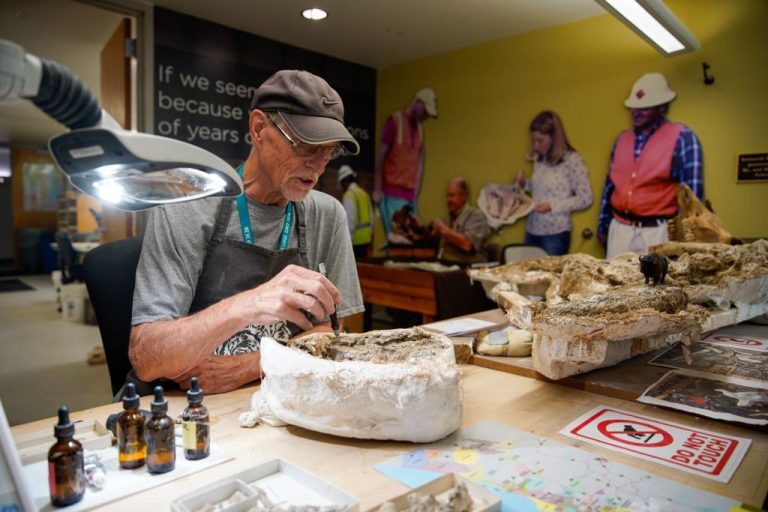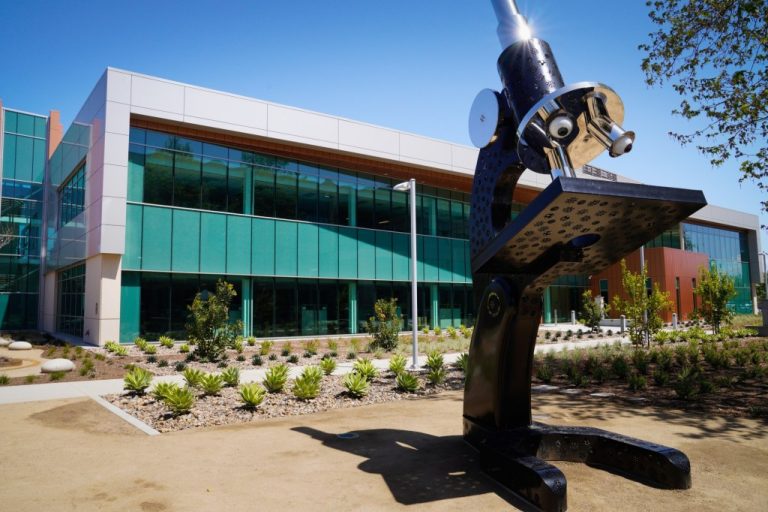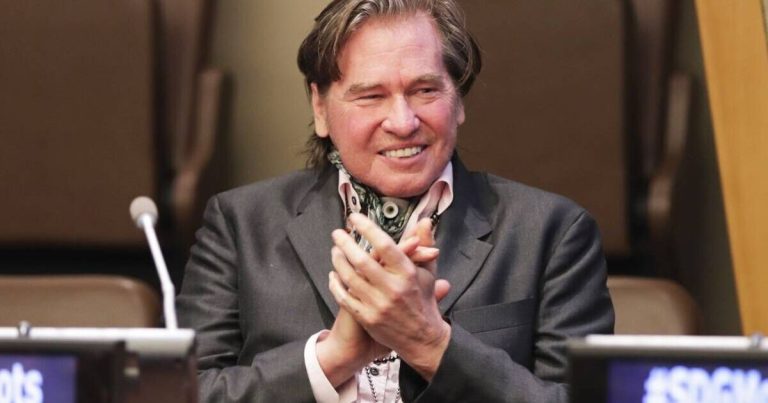
The Padres took advantage of a soft market to pounce and sign Manny Machado before the 2019 season.
At the trade deadline in 2020, when they splurged to add 10 players, the Padres were practically the only team in “buy” mode.
And Major League Baseball was still reeling from the COVID-19 shutdown and bracing for the 2022 lockout when A.J. Preller again went wild in the 2020-21 offseason, trading for three front-end starting pitchers and signing infielder Ha-Seong Kim.
The mass and marquee moves the Padres made during those periods of relative market inertia helped them become contenders over the past four seasons, two of which resulted in playoff appearances.
Their next attempt at improving their club comes with new challenges.
“It feels like right now it’s a pretty competitive league and there’s a bunch of teams that have a chance to play in the postseason,” Preller, the Pades President of Baseball Operations, acknowledged this week at the general manager meetings.
The Padres are seeking starting pitching, primarily. And while that market is always a competitive one, this winter comes close to literally fulfilling the cliché that all 30 teams are actively striving to improve their rotation. The Padres have no way of controlling what almost every other team seems set to do this winter.
A half-dozen top-flight starters and another dozen or so middle-tier arms are available via free agency. But multiple league executives and agents said they expect 20 teams to be serious players in that market.

The Padres are paying Yu Darvish, above, and Joe Musgrove like front-end starters.
(Meg McLaughlin/The San Diego Union-Tribune)
The Padres already have two pitchers they are paying as front-end starters in Joe Musgrove and Yu Darvish. The team’s likely targets in free agency or trade attempts will be mid-rotation pitchers. And Preller indicated Wednesday his sights are set on perhaps finding projects similar to Seth Lugo and Michael Wacha, both of whom put together big seasons after singing with the Padres last offseason.
Looming over the Padres’ plans is their need, according to multiple team and league sources, to trim payroll by around $50 million. Such a cut would still likely place them in the top 10 in payroll, people in the organization have pointed out. They were third last year, behind the Mets and Yankees, both of whom missed the playoffs as well.
The World Series was won by the Rangers, who ranked fourth in payroll. The team they beat, the Diamondbacks, ranked 21st out of 30 clubs.
There is undoubtedly a correlation between spending and success.
Just two World Series champions in the past 10 full seasons — the Astros in 2017 and Royals in 2015 – have been ranked outside the top 10 in payroll. Of the 104 playoff teams over those 10 seasons, 29 were ranked in the top five in payroll in the season they made the playoffs, 26 were ranked from sixth to 10th, and 71 were ranked in the top half among the 30 teams.
Just 19 teams that made the playoffs in those 10 seasons were ranked in the bottom 10 in payroll. But seven of those made it in the past two seasons, including the Diamondbacks, Marlins (22nd), Rays (27th) and Orioles (28th) in 2023.
“The fact of the matter is the Diamondbacks won six more (regular season) games than us,” said Tigers President of Baseball Operations Scott Harris, whose team went 78-84. “And they got in the playoffs, and they got piping hot and got to the World Series.”

The Diamondbacks won the National League pennant with a payroll that ranked in the bottom third in baseball.
(Matt Slocum / Associated Press)
The Orioles and Diamondbacks were rebuilding in recent seasons, a process that involves stacking good decisions on top of each other over at least a multi-year period. Executives say rebuilding is still necessary for most teams.
But the Orioles’ ascension to being a playoff team came perhaps a year earlier than most expected. The Diamondbacks got more sustained pitching than some expected to back an emerging core and now seem emboldened to spend at least a little more than in recent seasons.
Things appear to be changing, in no small part because there is an extra playoff spot available in each league.
“If you look at the 30 teams and if you were to sit there and list the ones that aren’t openly talking about making the playoffs this year, it’s a very, very short list,” said Orioles General Manager Mike Elias, whose team won the vaunted and generally big-spending American League East. “And that’s unusual, I mean, looking back (at) the last 10 years. I think it’s healthy for the sport how few teams are openly rebuilding right now.”
Some in the league proffered that only the A’s and Nationals could be considered to be truly in a rebuild, meaning they would not be cluttering the buyers’ market at the upper end.
Harris cautioned that teams like the Tigers have to be careful to not be thrown off course by thinking the postseason prize is closer than it really is and give into a temptation to make impetuous moves.
“We have to be cautious as an organization,” he said. “… I want to be (at a point) where we’re very aggressive in free agency and trades. We just haven’t gotten there yet.”
Still, the Tigers are part of a tier of teams — with the Royals, Rockies and Pirates — that might not be seen from the outside as strong contenders but are expected to at least make a run at quality pitchers.
“I think that the way the playoffs are structured now does allow for more teams to stay in it, so to speak,” Twins President of Baseball Operations Derek Falvey said. “If there were only four spots instead of what we have now, that would change the dynamic a little bit for a few clubs that might be a little further on the rebuild end. … We knew that Detroit and Kansas City, in particular, were teams that said they were rebuilding. But now we’re seeing those good young players establish themselves at a big-league level. So I only see our division getting better en masse. Ultimately, that will make it harder for us but hopefully we put ourselves right back in the mix next year.”
This influx of competition is the backdrop for the Padres as they attempt to compete in what now appears to also be a deeper National League West.
“I think you’re always aware of the dynamic and the climate,” Preller said. “I think it affects from a supply demand competition standpoint. You’re trying to get a sense of which teams are really gonna put the foot down and go for it (and) other teams that are maybe more on the periphery. That’s always part of how we try to evaluate the market and what’s out there. Not really from a decision standpoint, like whether to sign somebody or not in terms of like the type of player we’re looking for. But how to get to them, how much competition for those players, yeah, it definitely factors in.”





